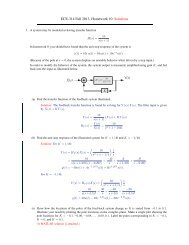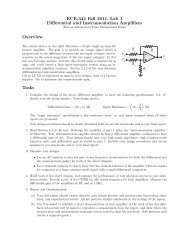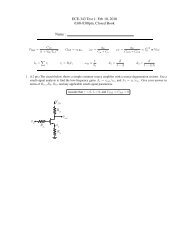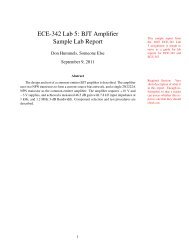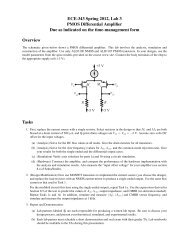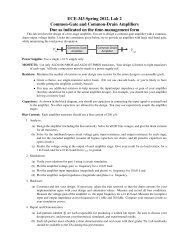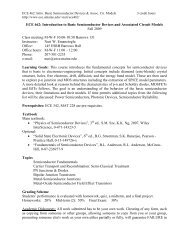Open-Loop Op-Amp Characteristics (first-order model) Closed-Loop ...
Open-Loop Op-Amp Characteristics (first-order model) Closed-Loop ...
Open-Loop Op-Amp Characteristics (first-order model) Closed-Loop ...
You also want an ePaper? Increase the reach of your titles
YUMPU automatically turns print PDFs into web optimized ePapers that Google loves.
<strong><strong>Op</strong>en</strong>-<strong>Loop</strong> <strong>Op</strong>-<strong>Amp</strong> <strong>Characteristics</strong>(<strong>first</strong>-<strong>order</strong> <strong>model</strong>)Exponential Model:)i D = I s(e v D/nV T− 1 ≈ I s e v D/nV TI s : Reverse Saturation CurrentV T : Thermal Voltage (≈ 25.8 mV at 300K)n : Ideality Coefficient<strong>Closed</strong>-<strong>Loop</strong> <strong>Op</strong>-<strong>Amp</strong> <strong>Amp</strong>lifiers(<strong>first</strong>-<strong>order</strong> op-amp <strong>model</strong>)A 0 large, low-frequencies:(v 0 = 1 + R )2R 1} {{ }non-inverting gainv 1 − R 2v 2R} {{ 1}inverting gainv D = nV T ln (i D /I S )r D = nV T /I DDiode Breakdown:-3 dB bandwidth (either input): f BW = f T1 + R 2R 1(Finite A 0 −→ Gains reduced by 1 + 1 + R )2/R 1A 014001200Carrier Mobility for Silicon, 300KMobility ( cm 2 /V−sec )1000800600Electron Mobilityn i=1.5 x 10 10 at 300KSi Approximation:n i2doubles every 5 degreesn i 2 ∝T 3 e − E G /kTE G=1.12 eV400Hole Mobility200010 15 10 16 10 17 10 18 10 19 10 20Total Impurity Concentration (cm −3 )
Periodic Table SegmentIII IV VB C NAl Si PGa Ge AsIn Sn Sbk = 8.62 × 10 −5 eV/K= 1.38 × 10 −23 J/Kq = 1.60 × 10 −19 coulombɛ 0 = 8.854 × 10 −14 F/cmV T = kT/q = 25.8 mV at 300KIntrinsic Silicon at 300K:E G = 1.12 eV ɛ r = 11.7n i = p i = 1.5 × 10 10 cm −3µ n ≈ 1350 cm 2 /V · sD n ≈ 34.8 cm 2 /sµ p ≈ 480 cm 2 /V · sD p ≈ 12.4 cm 2 /sCharge Movement In SemiconductorsD nµ n= D pµ p= V T np = n 2 iJ drift = pqµ p E +nqµ n E = q(pµ p +nµ n )E = E ρ(J diff = D n q dn ) (− D p q dp )dx dxρ =1q(pµ p + nµ n )R = ρ LtW = ( ρt) ( )WL( )NA N DV 0 = V T lnn 2 i√ (2ɛ 1w D0 = x n0 + x p0 =q V 0 + 1 )N A N D√w D = w D0 1 − v DV 0(i D = n 2 Dni qA +D )pL n N A L p N D} {{ }I s(( )N Ax n0 =w D0 x p0 =N A + N D√x n = x n0 1 − v DV 0) ( )e v D/V T− 1 = I s e v D/V T− 1(NDN A + N D)w D0x p = x p0√1 − v DV 0L n = √ D n τ n L p = √ D p τ p C J = ɛA C J0=w D (1 − V D /V 0 ) m C DIFF = τ TI D ≈ τ T I sV TV Te V D/V T(i C = αi E = βi B = I s e v BE/V T1 + v )CEV AV T = kT q≈ 25.8 mV at T = 300 K α =ββ + 1i D = k ′ W L[(v GS − V t )v DS − 1 ]2 v2 DSi D = k′ W2 L (v GS − V t ) 2 (1 + λv DS ) λ = 1 = λ′V A Lk ′ 1= µ n C ox = k ′ W r DS L (V GS − V t ) = k ′ W L V OV[ √2φfV t = V t0 + γ + V SB − √ ]2φ f
g m = I Cr 0 = V A + |V CE |≈ V AV T I C I Cr π = βg mr e = αg mg m = k ′ W L V OV = 2I DV OVr 0 = V A + |V DS |I D≈ V AI Dg mb == √ 2k ′ (W/L)I D(γ)2 √ 2φ f + |V SB |} {{ }χg m



